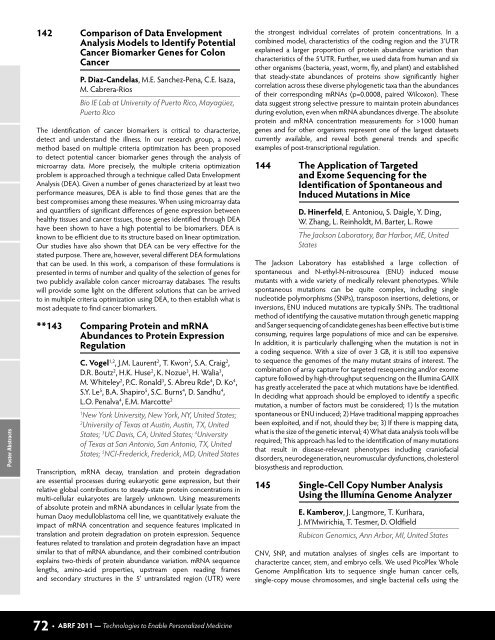Conference Program - ABRF 2011 - Association of Biomolecular ...
Conference Program - ABRF 2011 - Association of Biomolecular ...
Conference Program - ABRF 2011 - Association of Biomolecular ...
- No tags were found...
You also want an ePaper? Increase the reach of your titles
YUMPU automatically turns print PDFs into web optimized ePapers that Google loves.
Poster Abstracts142 Comparison <strong>of</strong> Data EnvelopmentAnalysis Models to Identify PotentialCancer Biomarker Genes for ColonCancerP. Diaz-Candelas, M.E. Sanchez-Pena, C.E. Isaza,M. Cabrera-RiosBio IE Lab at University <strong>of</strong> Puerto Rico, Mayagüez,Puerto RicoThe identification <strong>of</strong> cancer biomarkers is critical to characterize,detect and understand the illness. In our research group, a novelmethod based on multiple criteria optimization has been proposedto detect potential cancer biomarker genes through the analysis <strong>of</strong>microarray data. More precisely, the multiple criteria optimizationproblem is approached through a technique called Data EnvelopmentAnalysis (DEA). Given a number <strong>of</strong> genes characterized by at least twoperformance measures, DEA is able to find those genes that are thebest compromises among these measures. When using microarray dataand quantifiers <strong>of</strong> significant differences <strong>of</strong> gene expression betweenhealthy tissues and cancer tissues, those genes identified through DEAhave been shown to have a high potential to be biomarkers. DEA isknown to be efficient due to its structure based on linear optimization.Our studies have also shown that DEA can be very effective for thestated purpose. There are, however, several different DEA formulationsthat can be used. In this work, a comparison <strong>of</strong> these formulations ispresented in terms <strong>of</strong> number and quality <strong>of</strong> the selection <strong>of</strong> genes fortwo publicly available colon cancer microarray databases. The resultswill provide some light on the different solutions that can be arrivedto in multiple criteria optimization using DEA, to then establish what ismost adequate to find cancer biomarkers.**143 Comparing Protein and mRNAAbundances to Protein ExpressionRegulationC. Vogel 1,2 , J.M. Laurent 2 , T. Kwon 2 , S.A. Craig 2 ,D.R. Boutz 2 , H.K. Huse 2 , K. Nozue 3 , H. Walia 3 ,M. Whiteley 2 , P.C. Ronald 3 , S. Abreu Rde 4 , D. Ko 4 ,S.Y. Le 5 , B.A. Shapiro 5 , S.C. Burns 4 , D. Sandhu 4 ,L.O. Penalva 4 , E.M. Marcotte 21New York University, New York, NY, United States;2University <strong>of</strong> Texas at Austin, Austin, TX, UnitedStates; 3 UC Davis, CA, United States; 4 University<strong>of</strong> Texas at San Antonio, San Antonio, TX, UnitedStates; 5 NCI-Frederick, Frederick, MD, United StatesTranscription, mRNA decay, translation and protein degradationare essential processes during eukaryotic gene expression, but theirrelative global contributions to steady-state protein concentrations inmulti-cellular eukaryotes are largely unknown. Using measurements<strong>of</strong> absolute protein and mRNA abundances in cellular lysate from thehuman Daoy medulloblastoma cell line, we quantitatively evaluate theimpact <strong>of</strong> mRNA concentration and sequence features implicated intranslation and protein degradation on protein expression. Sequencefeatures related to translation and protein degradation have an impactsimilar to that <strong>of</strong> mRNA abundance, and their combined contributionexplains two-thirds <strong>of</strong> protein abundance variation. mRNA sequencelengths, amino-acid properties, upstream open reading framesand secondary structures in the 5’ untranslated region (UTR) werethe strongest individual correlates <strong>of</strong> protein concentrations. In acombined model, characteristics <strong>of</strong> the coding region and the 3’UTRexplained a larger proportion <strong>of</strong> protein abundance variation thancharacteristics <strong>of</strong> the 5’UTR. Further, we used data from human and sixother organisms (bacteria, yeast, worm, fly, and plant) and establishedthat steady-state abundances <strong>of</strong> proteins show significantly highercorrelation across these diverse phylogenetic taxa than the abundances<strong>of</strong> their corresponding mRNAs (p=0.0008, paired Wilcoxon). Thesedata suggest strong selective pressure to maintain protein abundancesduring evolution, even when mRNA abundances diverge. The absoluteprotein and mRNA concentration measurements for >1000 humangenes and for other organisms represent one <strong>of</strong> the largest datasetscurrently available, and reveal both general trends and specificexamples <strong>of</strong> post-transcriptional regulation.144 The Application <strong>of</strong> Targetedand Exome Sequencing for theIdentification <strong>of</strong> Spontaneous andInduced Mutations in MiceD. Hinerfeld, E. Antoniou, S. Daigle, Y. Ding,W. Zhang, L. Reinholdt, M. Barter, L. RoweThe Jackson Laboratory, Bar Harbor, ME, UnitedStatesThe Jackson Laboratory has established a large collection <strong>of</strong>spontaneous and N-ethyl-N-nitrosourea (ENU) induced mousemutants with a wide variety <strong>of</strong> medically relevant phenotypes. Whilespontaneous mutations can be quite complex, including singlenucleotide polymorphisms (SNPs), transposon insertions, deletions, orinversions, ENU induced mutations are typically SNPs. The traditionalmethod <strong>of</strong> identifying the causative mutation through genetic mappingand Sanger sequencing <strong>of</strong> candidate genes has been effective but is timeconsuming, requires large populations <strong>of</strong> mice and can be expensive.In addition, it is particularly challenging when the mutation is not ina coding sequence. With a size <strong>of</strong> over 3 GB, it is still too expensiveto sequence the genomes <strong>of</strong> the many mutant strains <strong>of</strong> interest. Thecombination <strong>of</strong> array capture for targeted resequencing and/or exomecapture followed by high-throughput sequencing on the Illumina GAIIXhas greatly accelerated the pace at which mutations have be identified.In deciding what approach should be employed to identify a specificmutation, a number <strong>of</strong> factors must be considered; 1) Is the mutationspontaneous or ENU induced; 2) Have traditional mapping approachesbeen exploited, and if not, should they be; 3) If there is mapping data,what is the size <strong>of</strong> the genetic interval; 4) What data analysis tools will berequired; This approach has led to the identification <strong>of</strong> many mutationsthat result in disease-relevant phenotypes including crani<strong>of</strong>acialdisorders, neurodegeneration, neuromuscular dysfunctions, cholesterolbiosysthesis and reproduction.145 Single-Cell Copy Number AnalysisUsing the Illumina Genome AnalyzerE. Kamberov, J. Langmore, T. Kurihara,J. M’Mwirichia, T. Tesmer, D. OldfieldRubicon Genomics, Ann Arbor, MI, United StatesCNV, SNP, and mutation analyses <strong>of</strong> singles cells are important tocharacterize cancer, stem, and embryo cells. We used PicoPlex WholeGenome Amplification kits to sequence single human cancer cells,single-copy mouse chromosomes, and single bacterial cells using the72 • <strong>ABRF</strong> <strong>2011</strong> — Technologies to Enable Personalized Medicine


